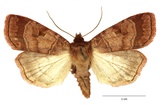Paradiarsia punicea (Hübner, [1803]) Species
Last modified: Oct. 20, 2025, 2:15 p.m.
This very rare and local species has not been seen in the southern part of Belgium for a long time. Probably extinct.
Paradiarsia punicea is heavily endangered in central Europe. The main reason is as usual destroyment or decline in quality of habitat.
Details
- Classification
- Family: Noctuidae > Subfamily: Noctuinae > Tribus: Noctuini > Genus: Paradiarsia > Species: Paradiarsia punicea
- Vernacular names
- Schaduwbreedvleugeluil (NL), La Diarsie grenadine (FR), Moorheiden-Bodeneule (DE)
- First mention in Belgium
- De Sélys-Longchamps E. 1844. Énumération des insectes Lépidoptères de la Belgique. — Mémoires de la Société royale des Sciences de Liége 2: 1–35. On page 11 (as Noctua punicea H.). view page
- Status
-
Native
Distribution
Bionomics
The larva hibernates in the penultimate instar. The larvae hided in the ground vegetation during daytime and could be beaten.
The adults come to light and sugar.
Flight periods
Adults are on the wing from late May and July or even early August with a peak in the second half of June.
Observed on
- Host plant (species):
- Caltha palustris
- Host plant (genera):
- Rubus, Taraxacum and Carex
The larvae are polyphagous in the herb layer and use a quite broad spectrum of herbs and grasses, occasionally probably also low-growing shrubs.
Rubus species are favoured, but also on Filipendula ulmaria, Valeriana officinalis etc...
Habitat
It inhabits a broad variety of low nutrient-rich wetlands like small birch clear-cuts in moorlands, bushy woodland edges in humid, open forests, riparian woodlands and similar places.


